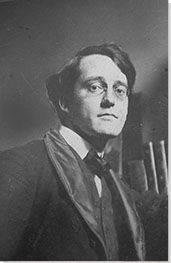Summary of John Sloan
Documenting city life with an unflinching eye, John Sloan's realism was part of an early 20th-century revolution in American art. Turning their backs on the refined subjects and styles of traditional art, the members of The Eight, commonly known as the Ashcan School, captured the everyday experiences of modern life. Sloan was central to the group's formation, and as an agitator for free artistic expression and new exhibition spaces, he was critical in bringing this new style to the public's attention. Along with Robert Henri, Sloan brought American art to both national and international acclaim.
Accomplishments
- Part of a circle of artists who studied under Robert Henri, John Sloan was a founding member of the Eight. Often referred to as the Ashcan School, for their straightforward depiction of gritty urban life, they were among the first American artists to challenge the traditional subjects and styles of high art.
- John Sloan captured a range of people, including prostitutes and working women, but unlike many of his contemporaries, Sloan did not paint critical or moralizing versions of his subjects. Instead, he presented them to the viewer in an unidealized, but ambiguous fashion, preserving all the details of their unconventional lives without passing judgment.
- Inspired by his personal commitment to radical politics, John Sloan was a fierce advocate for artistic freedom. His organizational skills were essential to the foundation of independent venues that exhibited art without the approval of a jury. The largest of these groups, the Society of Independent Artists, would run from 1917-1944 (with Sloan serving as president for all but the first year).
Important Art by John Sloan
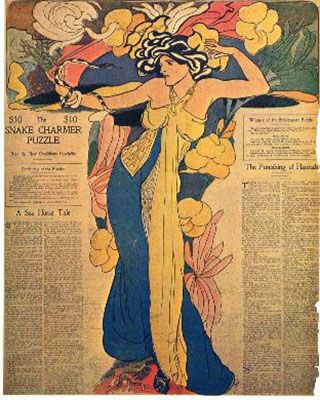
Snake Charmer Puzzle
Sloan's foray into the art world began as an illustrator for newspapers and a designer of book covers and posters. His ability to succinctly yet artistically render eye-catching subjects and craft sophisticated questions made him a highly popular puzzle designer. This work on paper was created during his employment at the Philadelphia Press, where he created puzzles for the newspaper's Sunday edition from 1899. In this particular puzzle, readers are asked to find hidden flute player within the drawing of a snake charmer, submitting their answers to the paper who would award prizes.
While these puzzle drawings provided a much-needed income for Sloan, they were also an important opportunity for the largely self-taught artist to hone his skills. While he would become best known for his realist Ashcan School paintings, these early works show Sloan's earlier versatility in the Art Nouveau poster style. According to David Scott, in describing these paintings, "Sloan thoroughly enjoyed the work, and he poured ingenuity and imagination into the games he played with words, shapes, and colors.
Characteristic of Art Nouveau, Sloan's line ran into spirited fantasy when it had the freedom to take off on rhythmic excursions depicting plant forms, flowing hair, billowing or patterned drapery, or swirling water. Decorative passages were carried exuberantly to the verge of independent abstractions." Here, Sloan's colorful illustration features a woman, gracefully captured in motion with an "s" shape curve to her body. Her left arm is bent at a ninety-degree angle with her hand pointing towards the snake which she watches as it curls its way around her arm.
Ink and watercolor, color linecut reproduction - Collection of Delaware Art Museum, Wilmington, Delaware
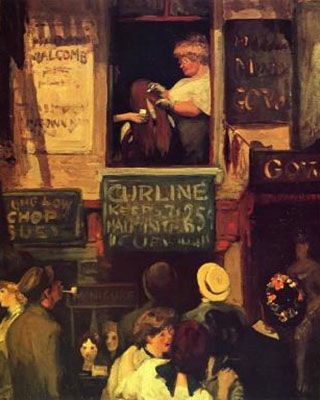
Hairdresser's Window
For both the viewer and the figures in this street scene, the focal point of Sloan's painting is a female hairdresser, visible through the second story window of a building. Positioned in side profile, with gloved hands she is coloring the long red hair of a woman whose back is turned to us. It is a slice of everyday life, complete with the overwhelming visual display that characterized the urban experience in the early 20th century.
This work is an important early example of the Ashcan School, a group in which Sloan played a key role. Artists associated with this style featured day-to-day moments of life in New York City, preserving their mundane but gritty realism. At the same time, the painting becomes a statement about looking - both at the painting itself and at the world. According to John Loughery, "the theme of the window frame and the very act of looking inevitably became almost a preoccupation for Sloan...."
Sloan spent hours walking the city streets and sketching scenes like the one found here. He also worked from his window and rooftop, watching people go about their lives. At the same time that he documented this urban community, he often captured loneliness, the lack of connection, and the sense of isolation that can exist among a crowd. The private act of grooming is performed for an audience (unknown to the client), but all of these people remain strangers to each other. It is an accidental community, bound together for a fleeting instant.
Oil on canvas - Collection of The Wadsworth Atheneum, Hartford, Connecticut
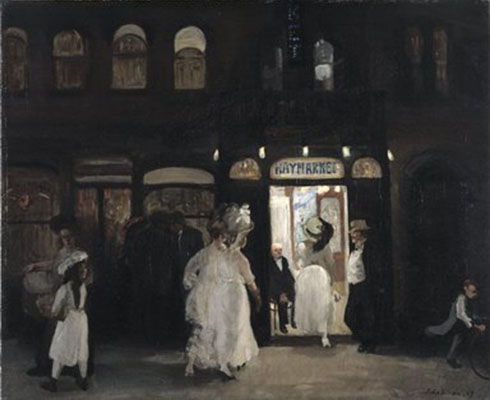
The Haymarket, Sixth Avenue
A contrast in colors, John Sloan's painting features a group of women, elegantly dressed in white, entering a building in the darkness of evening. The sign above the open, illuminated doorway reads "Haymarket."
The painting, one of many New York City-themed works Sloan created as part of The Eight, depicts a dance hall. This was a scandalous subject, particularly as the women were shown entering the building (a dance hall of ill repute) without male escorts. This characterized them as independent modern women, in search of pleasure and not bound by the expectations of proper genteel society. This was radical for American art.
Despite its provocative subject, however, Sloan refrained from overt social commentary or critique. Even though he was personally involved with radical politics, Sloan's paintings generally lacked the social criticism that was the main goal for some of The Eight. Rather than showing city life through a single lens, Sloan's works are often morally ambiguous. According to John Loughery, for Sloan "...the city encompassed squalor and exuberance at one and the same time, and that moments of anguish and exhilaration were not antithetical but necessarily linked, or not so much overlapping as entwined."
Perhaps influenced by the unconventional background of his wife, Dolly, who had worked in a brothel, Sloan is often sympathetic to working women. Specifically in this work, the historian Thomas J. Gilfoyle claims that Sloan's representations of these prostitutes are more human, and that, "instead of depicting the prostitute in a brothel or as an offering for the supporting male, Sloan presented her as she presented herself and her neighborhood. The prostitute was, in essence, an ordinary woman."
Oil on canvas - Collection of Brooklyn Museum, Brooklyn, New York
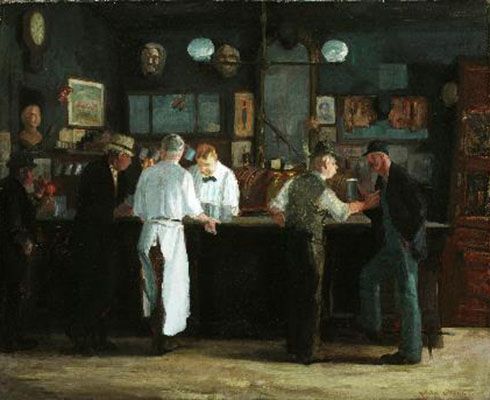
McSorley's Bar
While working in the Ashcan School style, Sloan created many scenes of daily life in New York City; but what is important in this scene is that he was not simply an impartial observer at this bar, but a regular patron of the establishment. Interested in the range of customers at the (now legendary and still functioning) McSorley's bar, which only admitted men, Sloan captured these figures in a moment of animated conversation. Like Sloan's paintings of women, the men are presented without judgment or criticism, but rather with a detached fascination for their poses, gestures, and character.
In this painting, the large wood bar dominates the center of the composition, but it unites rather than divides the employees and the patrons. Distinguished by their white shirts and aprons, the two men tending bar are at the center, contrasting with the visitors who are engaged in conversation and drinks. The effect is lively, but not exceptional in any fashion; Sloan gives us an insight into an ordinary scene of daily life without embellishing it for greater dramatic effect.
Oil on canvas - Collection of Detroit Institute of Arts, Detroit, Michigan
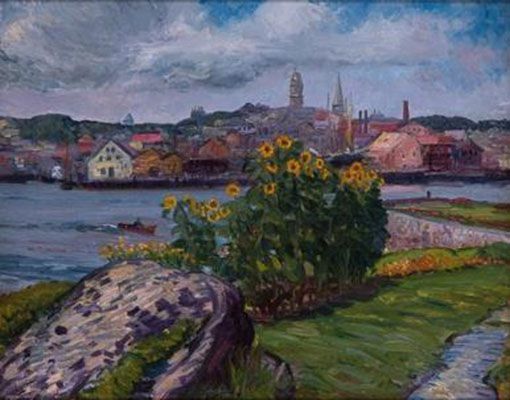
Sunflowers, Rocky Net
Water dominates the center of Sunflowers, Rocky Net, nestled between a distant village of houses and steepled buildings and a patchy field of green grass in the foreground. A large rock on the left stands in stark contrast to the wild sunflowers that grow along the water's edge.
The summer of 1914 was important for Sloan, who joined the seasonal artistic community in Gloucester. Free from the often-oppressive burdens of city life, it was a period of explosive creativity for Sloan. In this first summer, he created sixty paintings in an attempt to meet a goal of making one painting a day. Most of these works featured the landscape views of Gloucester. In a shift from his usual working routines, the art historian John Loughery noted that Sloan got "into the 'habit of working,'" and would "paint outdoors every morning regardless of inspiration, and consider his art in a more abstract, less literary way." As we see in this work, when freed the gritty subjects of city life, Sloan adopted a looser brushstroke and incorporated a broader range of colors. The shift highlights the influence of the Impressionism and Post-Impressionism, specifically the sunflower motif suggests a visual nod to Claude Monet and Vincent Van Gogh.
The Gloucester landscapes marked a turning point for Sloan as he moved away from the Ashcan School style which had previously dominated his work. After this, he would explore a rich variety of approaches and styles in the remaining decades of his career.
Oil on canvas - Collection of Cape Ann Museum, Gloucester, Massachusetts
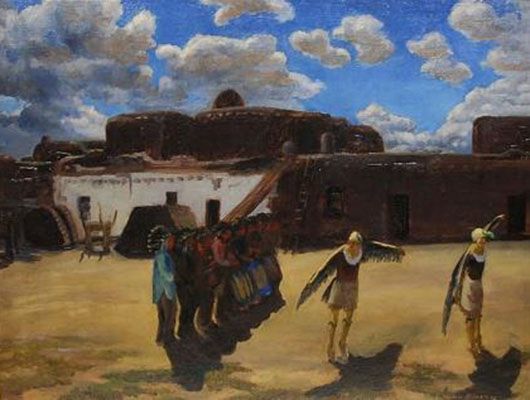
Eagles of Tesuque
John Sloan's painting Eagles of Tesuque features two members of the Pueblo Indian tribe performing the ceremonial Eagle dance. A line of Native Americans stand in a row to the left of the dancers. The background is a line of pueblo houses set against a brilliant blue, cloud-filled sky.
This work speaks to an important theme in Sloan's oeuvre: the landscapes and the people of the American Southwest. Following the advice of Robert Henri, Sloan began to summer in Santa Fe, New Mexico in 1919. Unlike anything he had experienced on the East Coast, the landscape provided much inspiration for his paintings of which the artist stated, "I like to paint the landscape of the Southwest because of the fine geometric formations and handsome color. [...] The ground is not covered with green mold as it is elsewhere. [...] Because the air is so clear you feel the reality of things in the distance." In time, this region would attract other modern artists, most notably Georgia O'Keeffe, drawn to the color and atmosphere, as well as the escape from the hectic life of New York City.
Oil on canvas - Collection of The Colorado Springs Fine Arts Center, Colorado Springs, Colorado
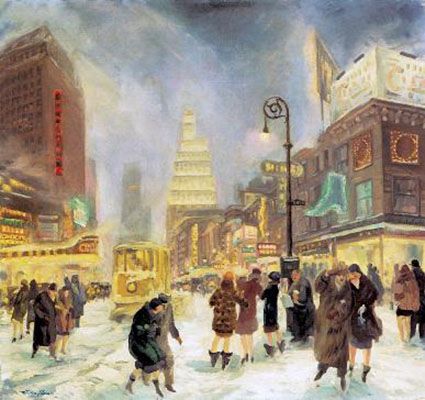
The White Way
Set at the busy intersection of New York City's Broadway and Fiftieth Streets, Sloan conjures a cold wintry day of snowy streets crowded with hurried pedestrians. Behind them are illuminated numerous buildings, a street light, and a trolley bus traveling down the street.
The inspiration for this work was made from a sketch he actually drew in the freezing cold, capturing the atmosphere and energy of a spontaneous moment. While the subject of city life had been a recurring theme for Sloan, this later work celebrated the city as bright and dynamic, with less attention on the individual experience than his earlier Ashcan School paintings. The work is more observational in nature, rendered in a lighter palette and looser brushstrokes that gives it a more impressionistic feel. This represented a general shift in Sloan's work; soon after this painting was finished, he would shift much of his attention to landscape paintings, portraits, and nudes.
Oil on canvas - Collection of Philadelphia Museum of Art, Philadelphia, Pennsylvania
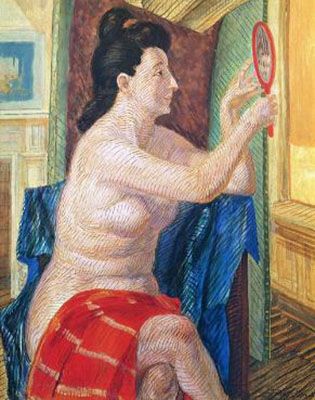
Nude with Red Hand Mirror
As reflected in the title, this painting features a nude female seated in a chair, legs crossed and partially covered with a red blanket, with her body turned to the right so that she can see her reflection in a small red mirror she holds in her right hand. She stands out from her surroundings, seeming almost too large for this small corner of the room, with her pale skin sharply contrasting with the vibrant blue cloth and red blanket around her.
This painting illustrates two characteristics of Sloan's later career in both its subject and its style. Beginning in the 1920s, Sloan began painting female nudes often. This painting also provides a good example of the unique cross-hatching line technique Sloan used to enhance his figures. Rather than sweeping brushstrokes, the dimensionality of the female's figure is rendered in a series of curving and overlapping lines.
This combination of a highly traditional subject with an innovative technique was not well received by many critics, nor the public who struggled to understand it. David Scott explained that contemporary viewers were troubled by the approach since "his figures basically represented a transcription of the visual world as we know it, whereas the surface markings belonged to another plane of abstraction." This combination of abstract and figurative design made his work less appealing to those who had previously appreciated his realism. At the same time, it remained too naturalistic to appeal to collectors of more abstract painting, leaving little market interest for these paintings. The decision to boldly change styles at this late stage of his career demonstrates Sloan's commitment to experimentation and his belief in artistic freedom. Despite the critical and financial consequences, John Sloan was indeed a modern artist, unafraid to push boundaries and try new things.
Tempera with overglaze on panel - Collection of The John Sloan Trust, Wilmington, Delaware
Biography of John Sloan
Childhood and Education
John French Sloan was the oldest child and only son of James Dixon Sloan and Henrietta Ireland Sloan. While his mother's family were wealthy paper and stationery merchants, his father struggled in business. Yet, as an amateur artist, his father encouraged the artistic interests of young Sloan, along with those of of his sister, Marianna, who would also grow up to be an artist. At the age of 16, he left school and began working full-time to support his family.
Early Training
Sloan worked at the Philadelphia bookstore, Porter & Coates, where he taught himself by copying the prints sold in the store. His etchings were so good that the shop's owner offered them for sale.
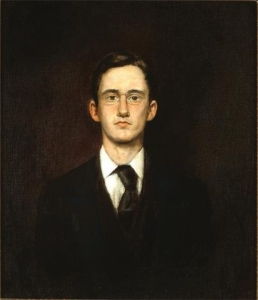
Not until 1890 did Sloan begin formal art training, enrolling in a class at the Spring Garden Institute in Philadelphia. With growing confidence in his skills, in 1891 he set out as a freelance artist. Eventually he began working for newspapers as an illustrator, a career that would last for decades. Enjoying the camaraderie of his fellow staff artists, he later described this time as better than college with "all the fun and no examinations." The posters and advertisements he created for these newspapers were based in an Art Nouveau style and often included witty and sophisticated puzzles and games.
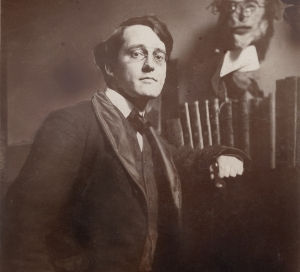
Sloan enrolled in the Pennsylvania Academy of Fine Arts, where he met the artist Robert Henri at an 1892 Christmas party. Henri would become a mentor and father figure to Sloan; Henri's Charcoal Club offered young artists a less expensive, more open-minded art training than was being offered at the Academy. The group also met at Henri's studio for weekly Thursday evening gatherings where discussions of art were coupled with shenanigans and socializing.
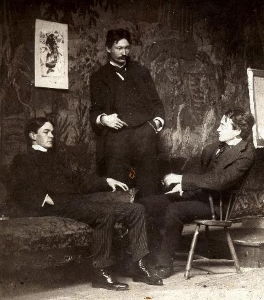
In 1894, Sloan's discontent with the Academy came to a head when a professor chastised him for sketching a classmate instead of the official model. He quit the school, marking the end of his traditional art education, and relied on his growing reputation as an illustrator and poster artist for financial support. He was prolific: between 1902 and 1916 he created more than 900 illustrations for books and magazines in addition to a steady stream of work for the Philadelphia Press where his puzzle drawings for the paper's Sunday edition were widely popular.
On a personal note, when a friend took the socially reserved Sloan to a Philadelphia brothel in 1898, he formed an instant attachment to one of the women. By the end of his first meeting with Anna Wall (better known as Dolly), he expressed his serious feelings for her and convinced her to leave her current partner. Despite the concerns of his friends, he began living with Dolly and they married in 1901. Their life together was complicated by Dolly's emotionally instability, frequent illnesses, and lifelong battles with alcoholism.
Mature Period
In 1904, Sloan moved to New York City, joining the circle of Henri artists who were already living there. He immediately began to create paintings that captured day-to-day moments of city life. Known as The Eight, this group shared a style of gritty realism and urban scenes that led to their nickname: The Ashcan School. Sloan became a major force in the organization and promotion of their work. When their untraditional realist themes were rejected from established exhibitions, Sloan was instrumental in organizing a show of their work at the Macbeth Gallery in February 1908. Highly publicized, the exhibition was a breakthrough for the American avant-garde, loosening the control held by more conservative art institutions. He helped to organize a much larger show of independent artists in 1910. Many members of the Henri circle were included in the 1913 Armory Show, marking The Eight's contribution to the advancement of modern art in America. Despite the stylistic differences among the Eight, their commitment to modern realism and artistic independence was facilitated by Sloan's diligence and dedication to the cause.
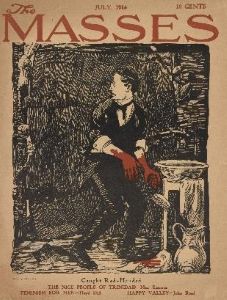
As Sloan's reputation as an artist was growing, so too was his interest in political activism. He and Dolly became devout supporters of Socialism. They were heavily involved in several campaigns to raise money to support striking workers and even to support the anarchist Emma Goldman. Sloan volunteered his time to serve as the art editor for the left-wing political magazine The Masses. He was a strong advocate for artistic freedom and the recognition of contemporary American artists. He was a founding member of the Society of Independent Artists (begun in 1917) and served as the organization's head for twenty-seven years.
In 1916, Sloan took his first full-time teaching job at the Art Students League. He liked the interaction with the students and their eagerness to learn from him. He also developed a reputation for challenging the established ways of teaching with one student describing his intensity as, "oh, how he rails against institutions; how he rails at commercial artists, portrait painters, etc!...He can swear real handy too." His classes were popular among students and his devout followers even referred to themselves as "the Sloanian nuts" with a deep sense of pride. One notable exception was a young Jackson Pollock, who allegedly dropped Sloan's drawing class when he wasn't allowed to focus on abstract imagery.
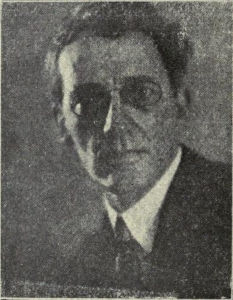
Sloan began spending his summer at the artistic colony in Gloucester, Massachusetts in 1914, however by 1919, he felt this retreat was becoming overcrowded. He was one of the first American modernists to begin summering in New Mexico, a change that inspired his future work. In addition to the new landscape forms, which were a great inspiration, he admired the work of the Native Americans of the Southwest. He became an advocate for tribal artists, first mounting an exhibition of their work at the Society of Independent Artists in 1922 and then by helping to bring about the Exposition of Indian Tribal Arts at a New York gallery in 1931; the show later traveled to other states and Europe.
Late Period
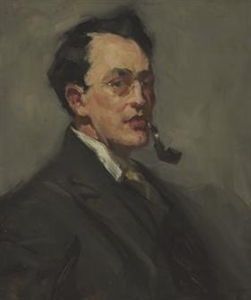
The last decades of Sloan's career focused more intensely on the landscape paintings of the American Southwest and an emerging interest in figures and nudes. Unfortunately for Sloan, his new approach (including cross-hatching lines to render the dimensionality of the figures and overglazing of the canvases) was not well received by the critics and his reputation declined.
During these years he suffered numerous health problems, incurring medical bills. He also had to deal with Dolly's intensifying drinking. She became jealous of any student or model who showed an interest in Sloan. Although he did have several affairs, he remained married to Dolly. In particular, one former student, Helen Farr, who joined the couple in New Mexico as she wrote a book of Sloan's teachings on art was a particular threat to Dolly. Despite her attempts to turn Sloan away from Farr, they began two-year affair in 1934 and the book "Gist of Art" was published in 1939.
After Dolly's death in March 1943, Helen Farr reached out to Sloan and they rekindled their relationship. The two married in February 1944 despite a forty-year age difference. With her support, Sloan's health recovered briefly and despite declining eyesight, he continued to paint. However, in 1951 he was diagnosed with cancer and died from complications after surgery.
The Legacy of John Sloan
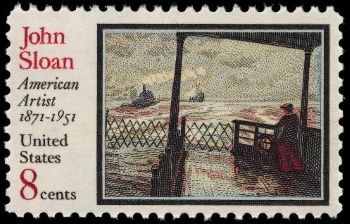
Sloan played a leading role in the Ashcan School's innovative and often gritty engagement with urban life. These paintings provided an unapologetic look at life and broadened the topics that were acceptable as fine art, advancing a uniquely modern American approach to realism. Although Sloan separated his personal politics from his painting, his unidealized examination of city life and his sympathy for his working class subjects would influence the Social Realists of the 1930s.
Sloan's teaching and his paintings helped to lay the foundation for the development of the Contemporary Realism movement, which can specifically be seen in the soft brushstrokes and vivid colors of Lois Dodd and Fairfield Porter. His work in creating new exhibition opportunities for independent artists, and his support of artistic freedom and innovation were crucial to the development of an American avant-garde.
Influences and Connections

-
![Arthur Dove]() Arthur Dove
Arthur Dove -
![Albrecht Dürer]() Albrecht Dürer
Albrecht Dürer -
![William Glackens]() William Glackens
William Glackens -
![Robert Henri]() Robert Henri
Robert Henri ![George Luks]() George Luks
George Luks
- Juliana Force
- George Otis Hamlin
- Charles Kraushaar
- John Kraushaar
- Gertrude Vanderbilt Whitney
-
![Arthur Dove]() Arthur Dove
Arthur Dove -
![William Glackens]() William Glackens
William Glackens -
![Robert Henri]() Robert Henri
Robert Henri ![George Luks]() George Luks
George Luks
- Juliana Force
- George Otis Hamlin
- Charles Kraushaar
- John Kraushaar
- Gertrude Vanderbilt Whitney
 Ask The Art Story AI
Ask The Art Story AI